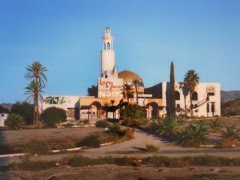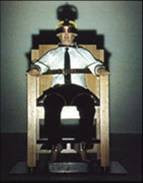CCA Andratx (Majorca), Andratx
29 September 2011 - 4 March 2012
 |
| Photo: The Long Labb |
Having lived in Spain I already knew that Madrid and Barcelona had a lot to offer in terms of contemporary art. Three years ago I visited family in Palma de Mallorca and was surprised to find a whole host of contemporary galleries showing international artists (Richard Billingham and Mark Francis were among the British artists represented). In addition to the commercial galleries Palma boasts two top class “exhibition halls” (Salas de exposiciones). One of which, La Caixa Foundation, is a bank which has other major exhibition centres in other major Spanish cities. Palma also boasts the Es Baluard Contemporary Art Museum.
I returned to Palma for Christmas this year and set about investigating what’s on when I came across “CCA” in the town of Andratx (30mins drive from Palma, or an hour on the bus). CCA is “the largest centre of contemporary art on Mallorca”. The bus driver had never heard of it, but it was actually well sign posted, although a little way out of the town. The space is amazing and CCA is a must for any contemporary art lover visiting Mallorca. Andratx is a small, but international town with a large German retiree population. However, CCA is caught in the trap of trying too hard to appeal to everyone. Locals (Spaniards and Germans alike) are catered for with its children’s room, ESPAI (an exhibition space for artists residing in Mallorca) and a commercial print room. More hardened international visiting art aficionados look to be challenged by the best Mallorca can offer. There were four main exhibitions on in the centre when I visited, which has four wings around a quad. One side is taken up with four artist-in-residence studios and a café. The reception, shop, print room and a children’s room take up opposite side. The two other sides are called the Kunsthalle and the Galleries.
The first two exhibitions were both eclectic group shows housed in the Kunsthalle wing of the building. The first, in Kunsthalle I, comprised of works from the AFM Collection and I was pleasantly surprised to see work by Phillip Allen, Varda Caivano, Martin Creed, Jim Lambie, Martin Boyce (2011 Turner Prize winner) and many other international artists. The curatorial team of the Art Foundation Mallorca is made up of (CCA director and co-founder) Patricia Asbaek (DK), Barry Schwabsky (US) and Friederike Nymphius (DE). All three are well known experts in Contemporary Art, travelling all year round to the leading art fairs, exhibitions and events taking place on the international art scene to identify the most talented artists and their best pieces for the AFM Collection. This show is a star-studded blockbuster but has no discernible theme, other than its baffling labelling system and the strip-light overload on the ceiling echoing Creed’s work, assembled in neat geometric shapes. The second show, in Kunsthalle II, celebrates 10 years of the centre’s artist in residence programme. The work from selected artists over the last decade was generally good, diverse and…Nordic. The owner of CCA is Danish, but the most represented Nordic nation was Germany.
 |
| Thoralf Knobloch Kaminfeuer (2004). Photo: The Long Labb |
I had no idea Thoralf Knobloch had done this residency and, as always, it was a pleasure to see one of his paintings. Jonathan Meese (also German) was another highlight although we were spared the full force of his overindulgent self-obsessed gay Nazi porn show installation (which I was lucky enough to catch while in The Hague recently). You can read more about that here, the show’s still on until January 15th so, if you’re in the Netherlands in the next couple of weeks…go on, have an unforgettable experience.
 |
| Jonathan Meese. Photo: The Long Labb |
Upon entering the galleries wing you come across Wall Sculpture (04.11.11 – 04.03.12), an exhibition by resident artist Paola Ricci. The corridor-esque gallery space was filled with drawings on tracing paper pinned to the walls, hairs stuck to paper (also pinned to the walls), envelopes, strings, lamps (on the floor) casting shadows of the artworks, a linear sculpture made from pointed sticks that reminded me of giant tooth-picks (but were probably barbecue skewers) and sheets of paper (pinned to the walls). The show reminded me of several resident “exhibitions” at the Centre for Drawing at Wimbledon College of Art where, as with this exhibition, I sometimes got the feeling that the artist – pushed for time on a short residency – looked for playful and readily available ingredients to fill the space quickly. Ricci’s work is playful and it’s not by coincidence that her choices of materials are light and ephemeral. Paradoxically, however, you are left with the feeling that her intentions are profound and weighty. Much of what she’s doing in this exhibition falls very much into the language of drawing more than sculpture.
 |
| Paola Ricci, Wall Sculpture, Mixed Media (2011). Photo: The Long Labb |
 |
| Henrik Saxgren, Unintended Sculptures series. Photo: The Long Labb |
Between the two gallery shows lay a couple of paintings of waves and one abstract reminiscent of Toma Abst, by British artist Rebecca Partridge. In another small, almost hidden, space (ESPAI) resident artist Olimpia Velasco is showing In Non Places (29.01.11 – 27.11.11). These two mini-exhibitions seemed a bit shoehorned in and wouldn’t have been missed if they had not been included at all. In general, although much of the work was good, there was too much of it and no clear theme to the two Kunsthalle shows. It would have been better to delay the AFM Collection show in Kunsthalle I and allow the CCA Collection 10 Years of Residency Programme show to breath and take over both halls. This was an opportunity for the curator to really celebrate the work achieved by the resident artists – perhaps stars like Knobloch and Meese could have been invited back to produce larger showstopper centrepieces. I really regret that this didn’t happen. On the other hand there is a buzz created by such a large amount of work, almost like a degree show. Perhaps this is the intention: to create a lived-in feeling of a space used by artists-in-residence. The residencies are clearly a successful and thriving part of the centre. They only last for about a month and there are four studios so there is certainly a dynamic turnover and output long may it continue, here’s to another ten years.




